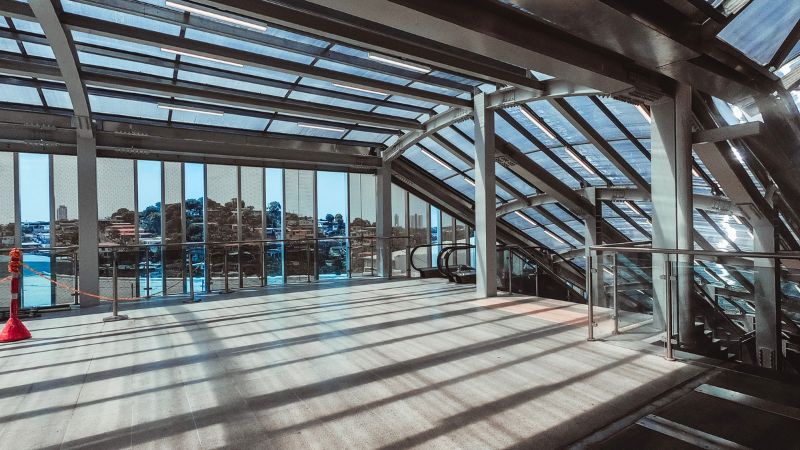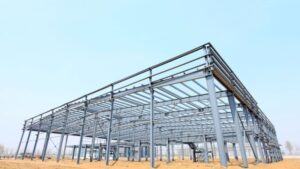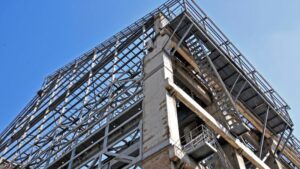Commercial Building Projects
Office Towers
When people build office towers, steel frames are very common. They allow you to create tall buildings with many floors. The main advantage is that steel can handle the weight of more stories without getting too bulky.
You can have large, open floor plans for offices, so teams can set up workspaces as needed. Steel makes it possible to use lots of glass, which brings in natural light and makes the space feel friendly and modern.
Benefits:
- Supports taller structures
- Allows open areas with few columns
- Fast to assemble compared to concrete
- Flexible for changes if you need to rearrange your office spaces
Steel office towers are easy to modify if a company’s space needs change over time. This flexibility is a major reason many cities choose steel for new skyscrapers.
Retail Centers
Retail centers and shopping malls use steel for both their frames and roofs. Since you want wide open areas without walls getting in the way, the long steel beams make this possible.
Shops come in different sizes, and sometimes tenants change. Having a steel structure lets you move walls or open up spaces with less trouble. You can also build retail centers quickly, helping new stores open on time.
Key Features:
- Large, open spaces for stores and walkways
- Easy to adjust layouts for new tenants
- Can support heavy equipment like HVAC systems and signs
Hotels
Many hotel buildings have repeating room layouts, so using steel modular pieces makes construction even faster.
Soundproofing and fire safety are important in hotels. Steel structures provide a solid base for adding insulation and safety features. They are also less likely to be damaged by pests, moisture, or weather compared to wood.
Why Choose Steel in Hotels?
- Fast to assemble, which is important when opening new locations
- Can support wide lobbies and large banquet halls
- Strong enough for rooftop pools or event spaces
Hotel owners also have the option to remodel and expand more easily since steel frames are adaptable if you want to add extra rooms or amenities.
Industrial Facilities
Warehouses
Warehouses need large, open areas without many columns getting in the way. Steel structures are ideal for this because they can span wide spaces with strong beams and frames.
You can easily add wide doors, high ceilings, and loading docks to steel warehouses. This is helpful for storing and moving goods with forklifts and trucks.
Steel warehouses are also fire-resistant, which helps keep inventory safe. The buildings can be expanded quickly if you need more storage in the future. Most steel warehouses are designed to be energy efficient, too.
Steel warehouse benefits:
- Large open floor plans
- Custom layouts
- Good protection from weather and fire
- Flexible for future needs
Manufacturing Plants
Manufacturing plants often use steel structures because machinery and equipment can be heavy and need strong floors and roofs. Steel offers the support these buildings need and can handle vibrations and movement from machines.
You may also need tall ceilings or cranes inside manufacturing plants. Steel frames make it easier to set up these features. Walls and roofs can have insulation to control temperature and reduce noise.
Main reasons to choose steel for manufacturing plants:
- Supports heavy equipment
- Allows for tall spaces and cranes
- Easier to change or expand the layout
Steel buildings can also be built fast, so you can get started sooner with production.
Distribution Centers
Distribution centers rely on steel construction for safe, efficient handling of goods. With tall racks and automated systems, these centers need wide open areas and strong roofs.
Steel lets you create layouts with aisles for robotics or conveyor belts. Large doors and loading docks are easy to add, so trucks can come and go quickly. Security features, such as locked entry points, are simple to install in steel frames.
Most steel distribution centers are built to hold heavy loads and require less upkeep over time. If your business grows, it’s easier to add more space or new areas as needed.
Bridges and Transportation Infrastructure
Highway Bridges
When you drive on a highway bridge, you are likely driving over a steel-supported structure. Steel beams and trusses carry heavy loads, helping bridges last for decades. They also resist weather and corrosion better with certain finishes, so the bridges need fewer repairs.
Building steel bridges is often faster than using concrete. The steel pieces are made off-site in factories, then quickly put together at the bridge location. You might notice that some of the largest and longest bridges use steel because it can span longer distances without extra support in the middle.
For areas with lots of traffic, steel makes it easier to widen bridges later. Engineers can add new sections without rebuilding the whole bridge. This flexibility helps keep roads open and reduces traffic jams during construction.
Railway Bridges
Steel is the main choice for many railway bridges. The weight of trains is much higher than cars or trucks, so steel structures are needed for the extra support. Steel also handles constant vibration from moving trains better than some other materials.
You will see steel in both modern and older railway bridges. For very busy railways, the long life and low maintenance of steel mean fewer delays. Some rail bridges must cross rivers or deep valleys. Steel allows for these long, unsupported spans, keeping trains traveling safely and smoothly.
Steel railway bridges can be pre-built in parts and put together quickly on site. This means train service is interrupted for a shorter time, which is important for busy routes. For maintenance, damaged steel pieces can be removed and replaced, keeping the bridge safe for use.
Airport Terminals
Airport terminals use large, open spaces to move people and luggage quickly. Steel frames, columns, and roof supports are the backbone of many modern terminals. These steel structures let you enjoy large waiting areas with fewer columns in the way.
Designers choose steel for terminals because it is both strong and can support creative shapes. You might notice wide glass walls and open ceilings supported by steel beams. These features bring in more natural light and help make airports feel bigger and more comfortable.
Steel is also quick to build with, which is important when airports need upgrades or new buildings. Special coatings protect the steel from rust, even in areas with lots of rain or humidity. This keeps airport buildings safe and looking good for years.
Residential Applications
High-Rise Apartment Buildings
If you live in or visit a tall apartment building, there’s a good chance the main parts of the structure are made from steel. Steel allows builders to go higher than with traditional wood or concrete. Because it is both strong and lighter than concrete, steel lets builders make slimmer columns and larger open spaces inside.
This means apartments can have more windows and big living spaces. Builders also like steel for tall buildings because it’s fast to put together and has less impact on the people living or working nearby during construction. Steel frames are resistant to fire and pests, so your apartment stays safer. It also makes maintenance easier and keeps the building looking good for longer.
Mixed-Use Developments
You may have seen buildings with shops, restaurants, and homes stacked on top of each other. These are called mixed-use developments, and steel structures are often used for these projects. The strength of steel supports different types of spaces on each floor.
For example, stores may need wide, open areas for displays and customers. Apartments above might be smaller and more private. Steel makes it easy to create both without using lots of support walls, which gives designers more freedom. Using steel also helps speed up construction, so neighborhoods get new homes and stores faster. Steel is a popular choice because it supports many uses in one building and meets safety codes.
Recreational and Public Structures
Sports Arenas
When you visit a sport arena, you probably notice the wide, open areas above the seats and field. Steel makes this possible by supporting long spans without needing many columns in the way. This lets everyone have clear views and gives athletes plenty of room.
Steel buildings are also fast to build, which helps new sports venues open on schedule. You’ll see steel used in local gymnasiums, big city stadiums, and indoor soccer fields. These structures are made to handle large crowds and the weight of lighting, sound, and screens.
Maintenance is easier because steel doesn’t rot or attract bugs like wood does. If your community is planning a new recreational center or gym, steel can help create a safe and long-lasting space.
Convention Centers
Convention centers need to host everything from meetings to large public gatherings, and steel is a main material for these projects. The open layouts give you space for exhibits, speeches, or special events, while the strong frames make it safe for hundreds or thousands of visitors.
With steel, you can design tall ceilings and wide halls that fit almost any event. It also makes it easier to adjust the space with movable walls or partitions. You might notice fewer columns in these buildings, which means extra room for booths and displays.
Fire safety is important too, and steel is non-combustible. This lowers fire risks and helps keep people safe during crowded events or emergencies.
Exhibition Halls
Exhibition halls are made to showcase products, art, or technology. Steel allows you to have wide, open rooms that show off these displays without obstacles in the way. This matters when you want a clear path to walk through the exhibits.
The flexibility of steel buildings lets you change floor plans for different shows or needs. You can hang heavy signs or lights from steel ceilings, and you don’t need to worry about the weight. The strong structure lets you open even huge rolling doors, making it easier to move large items in and out.
These halls are also very durable. You spend less on repairs and can focus on hosting events year after year in the same sturdy building.
Specialized and Tall Structures
Skyscrapers
You often see steel used for skyscrapers. Steel frames provide the strength needed to support floors stacked up to extreme heights. This allows for thinner walls and flexible design, giving you more open floor plans.
Steel is lightweight compared to concrete, which is important in tall buildings because it reduces the overall weight pushing down on the foundations. It’s also fast to work with. Many skyscraper frames can rise floor by floor, with steel parts simply bolted or welded in place.
A steel frame is not just strong; it is also flexible. This is helpful for skyscrapers in areas with strong winds or earthquakes, as steel structures can sway slightly without breaking. This flexibility helps keep buildings and people safe.
Telecommunication Towers
Telecommunication towers, like those you see supporting cell phone antennas, are almost always made of steel. Steel’s strength and light weight allow these towers to stand hundreds of feet tall while being slender and stable.
Most telecommunication towers use a lattice structure, which is a pattern of crisscrossing steel bars. This design uses less material for the same strength, making towers lighter and cheaper to build. The open design also helps the tower resist strong winds because air can move through it.
Steel is also easy to maintain. You can add or replace parts as technology changes or as repairs are needed, which keeps towers in service longer.
Observation Decks
Observation decks are designed to give people great views from high above the ground. Many observation decks are set on top of towers, tall buildings, or even bridges that use steel frames for support.
Steel gives you both the strength to hold up the deck and the flexibility to fit creative shapes or wide, open spaces. This makes steel a top choice for large viewing areas with glass walls or even outdoor balconies.
Because steel is strong but not too heavy, it lets you build the deck higher up and extend it farther out from the main structure. You often see this in famous tourist towers and city landmarks, where safety and stability are very important.


